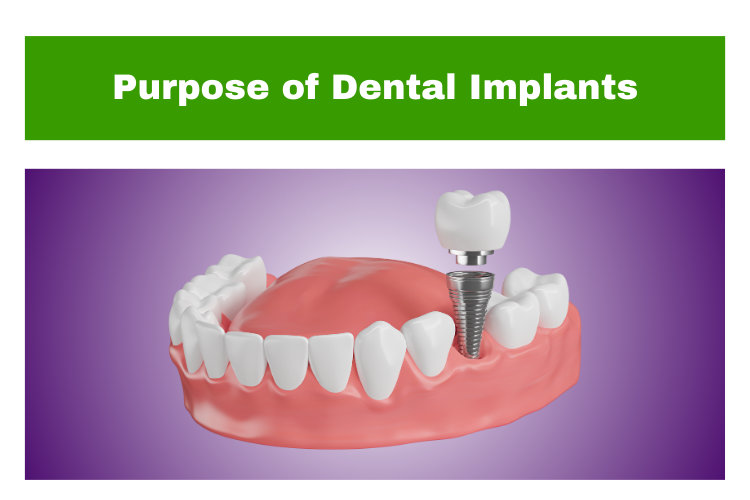Schedule Appointment




Have you ever wondered what happens when you lose a tooth? Many people assume that missing teeth only affect their appearance, but the reality is far more serious. A lost tooth can cause jawbone loss, shifting teeth, difficulty chewing, and even changes in facial structure.
This is why dental implants have become the gold standard in tooth replacement. Unlike dentures or bridges, implants mimic natural teeth in function and appearance. They restore not just your smile but also your oral health, confidence, and ability to chew properly.
In this article, we will discuss:
If you are considering tooth replacement, keep reading to understand why dental implants are the best long-term solution for missing teeth.
A dental implant is a titanium post surgically placed in the jawbone, acting as an artificial root for a missing tooth. It fuses with the bone over time through osseointegration, providing a stable foundation for a crown, bridge, or denture.
Learn more about dental Implants
Dental implants are designed to replace missing teeth and function just like natural teeth. They are composed of three key components: the titanium post, the abutment, and the crown. Each part plays a vital role in ensuring the implant’s stability, functionality, and natural appearance.
The titanium post is the foundation of the dental implant. Made from biocompatible titanium, it is surgically placed into the jawbone where the missing tooth was. Over time, the post undergoes a process called osseointegration, in which the bone fuses with the implant, providing a stable and permanent base. This process typically takes a few months and ensures that the implant remains secure, just like a natural tooth root. Unlike dentures, which rest on the gums, the titanium post prevents bone loss and maintains jaw structure.
Once the titanium post has fully integrated with the jawbone, an abutment is attached to it. The abutment serves as a connector between the implant post and the crown. It is a small metal piece, usually made of titanium or ceramic, that extends slightly above the gum line. The abutment provides support for the crown and ensures that it remains firmly in place. It is custom-made to fit each patient’s implant, ensuring a secure and comfortable fit.
The crown is the final and most visible part of the dental implant. It is custom-designed to match the color, shape, and size of the surrounding natural teeth. Made from durable materials like porcelain or ceramic, the crown provides a natural appearance while offering the strength needed for chewing and biting. Once the crown is attached to the abutment, the dental implant looks, feels, and functions like a real tooth.
Each part of a dental implant plays a crucial role in restoring both functionality and aesthetics. The titanium post ensures long-term stability, the abutment secures the crown, and the crown provides a natural look and feel. Together, these components create a strong, durable, and permanent tooth replacement solution.
Unlike dentures that sit on the gums or bridges that rely on adjacent teeth, dental implants integrate with the jawbone, offering superior stability, durability, and a natural feel.
Dentures can slip while eating or talking, causing discomfort. Bridges depend on nearby teeth for support, which may weaken them. Implants, however, fuse with the jawbone, providing a firm, secure, and permanent foundation without the need for adhesives.
Dentures and bridges need replacement every 5–10 years, while implants can last 20+ years with proper care. The titanium post bonds with the bone, ensuring a strong, long-term solution that requires minimal maintenance.
Implants look, feel, and function like natural teeth, allowing easy chewing and speaking. Unlike dentures, they don’t feel bulky or unnatural. The custom-made crown blends seamlessly with your existing teeth, enhancing both comfort and aesthetics.
Dental implants provide unmatched stability, longevity, and a natural experience. Unlike dentures and bridges, they preserve jawbone health, protect surrounding teeth, and offer a hassle-free, permanent solution for missing teeth.
Many people think that dental implants are simply a cosmetic solution, but they serve a much deeper purpose.
Missing teeth can make the face appear sunken and aged due to bone loss. Implants preserve jawbone density, maintaining facial structure and giving a more youthful appearance.
Unlike dentures that can slip, implants are securely anchored, allowing for better chewing and clearer speech. With dental implants, patients can eat all types of food without discomfort.
When a tooth is lost, the jawbone starts shrinking due to a lack of stimulation. Dental implants act like natural tooth roots, preventing bone deterioration and maintaining a strong jawline.
Gaps left by missing teeth cause adjacent teeth to move, leading to:
A dental implant fills the space, ensuring the teeth remain properly aligned.
There is no single type of dental implant. The right option depends on bone structure, dental health, and treatment goals.
Learn more about different types of Dental Implants
| Feature | Dental Implants | Bridges | Dentures |
| Longevity | 20+ years | 10-15 years | 5-8 years |
| Jawbone Health | Prevents bone loss | Mild bone resorption | Accelerates bone loss |
| Comfort | Feels natural | Moderate | Can slip and cause discomfort |
| Eating and Speaking | No restrictions | Some limitations | Difficulty chewing and speaking |
| Maintenance | Brush and floss normally | Special care needed | Requires adhesives and soaking |
Dental implants provide the most natural, long-lasting, and hassle-free solution for replacing missing teeth.
Dental implants permanently replace missing teeth while preserving jawbone health. They restore chewing ability, improve speech, and prevent facial sagging. Implants also enhance oral function and overall dental aesthetics.
With proper care, dental implants can last over 20 years or even a lifetime. They are more durable than bridges or dentures and require regular hygiene. Good oral care and dental check-ups ensure their longevity.
The procedure is done under local anesthesia, making it pain-free. Mild discomfort may occur after surgery but is manageable with medication. Most patients resume normal activities within a few days.
No, once a tooth is lost, it does not grow back naturally. Missing teeth can cause jawbone shrinkage and misalignment over time. Dental implants provide a permanent and effective replacement.
If you have lost a tooth, ignoring it can lead to jawbone loss, shifting teeth, and difficulty eating. Dental implants are more than just a cosmetic fix—they restore full oral function, long-term stability, and overall health.
Looking for a reliable solution for missing teeth? Contact Dr. Gowds Dental Hospital today for expert dental implant treatments.
Gachibowli Branch
Madhapur Branch
Koti Branch
Puppalaguda Branch